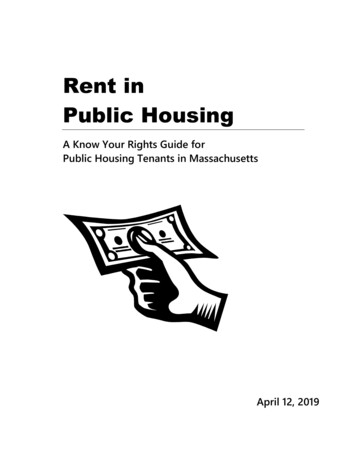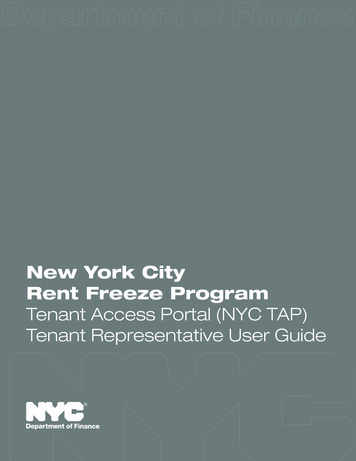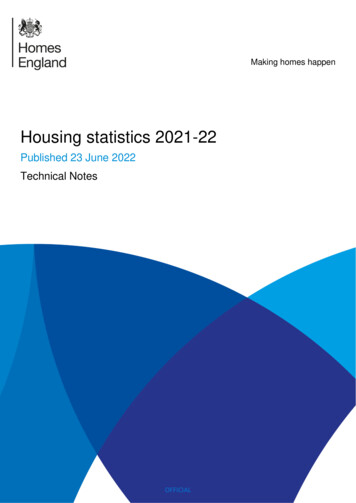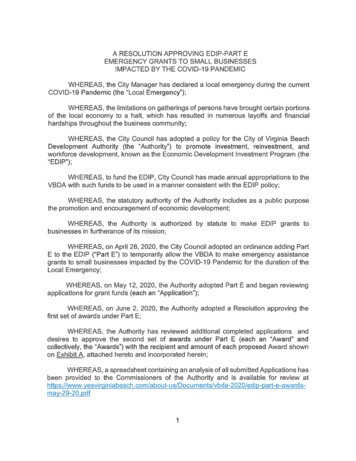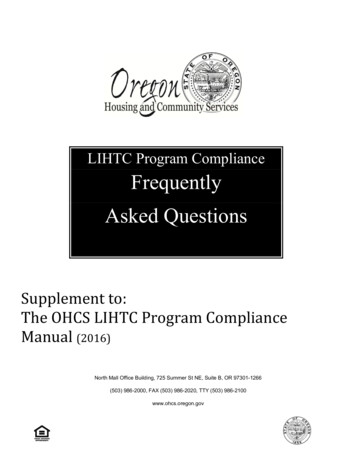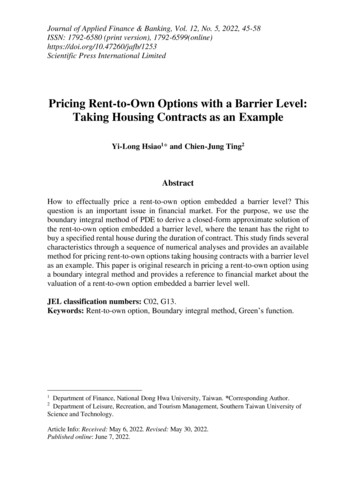
Transcription
Journal of Applied Finance & Banking, Vol. 12, No. 5, 2022, 45-58ISSN: 1792-6580 (print version), 3Scientific Press International LimitedPricing Rent-to-Own Options with a Barrier Level:Taking Housing Contracts as an ExampleYi-Long Hsiao1* and Chien-Jung Ting2AbstractHow to effectually price a rent-to-own option embedded a barrier level? Thisquestion is an important issue in financial market. For the purpose, we use theboundary integral method of PDE to derive a closed-form approximate solution ofthe rent-to-own option embedded a barrier level, where the tenant has the right tobuy a specified rental house during the duration of contract. This study finds severalcharacteristics through a sequence of numerical analyses and provides an availablemethod for pricing rent-to-own options taking housing contracts with a barrier levelas an example. This paper is original research in pricing a rent-to-own option usinga boundary integral method and provides a reference to financial market about thevaluation of a rent-to-own option embedded a barrier level well.JEL classification numbers: C02, G13.Keywords: Rent-to-own option, Boundary integral method, Green’s function.1Department of Finance, National Dong Hwa University, Taiwan. *Corresponding Author.Department of Leisure, Recreation, and Tourism Management, Southern Taiwan University ofScience and Technology.2Article Info: Received: May 6, 2022. Revised: May 30, 2022.Published online: June 7, 2022.
46Hsiao and Ting1. IntroductionRecently, many option characteristics have been embedded in residential leasecontracts. These options give tenants some rights to exercise renewal, to purchase,to cancel, or to break contracts. In fact, these contingent rights can change the futureterms of residential lease contracts. Thus, future payoffs to both tenants andlandlords are both contingent on and dependent on the underlying asset prices.Residential lease contracts with embedded options change the initial rent paymentsto a right or obligation to renew, to break, or to expand the terms of the lease, ascompared to standard residential lease contracts with no embedded options. One ofcommonly embedded options in residential lease contracts is a kind of purchaseoption, which gives the tenant the right to buy the predetermined real estate at aspecified price. We call this option a rent-to-own option. The right to own suchhouses increases the value of residential lease contracts.However, the simple embedded options referenced above, such as renewals,breaking the lease, or purchase options appear frequently in real estate markets, andsome additional special options have also been developed recently, such as anoption to impose barrier constraints. A barrier option is a path-dependent option,which comes in various frameworks, but its major characteristic is that this type ofoption is either started or terminated based on the underlying price bumping apredetermined level during pre-specified time intervals.This study investigates a special embedded option in residential lease contracts,which is one of the rent-to-own options for rental real estate by which tenants canexercise the right to buy the rental real estate early when the house price surpassesa predetermined benefit value. In addition, when the house price touches the prespecified barrier level, the contract writer terminates the option right and pays aspecific number of rebates to the contract owner. Therefore, the rent-to-own optionwith a barrier constraint will limit the tenant’s benefits. Residential lease contractrents embedded with a contingent purchase option with a barrier level are higherthan those in standard residential lease contracts without a purchase option, but arelower than that of standard residential lease contracts embedded with a purchaseoption without any barrier constraint. Furthermore, the embedded rent-to-ownoption with a barrier level in a residential lease contract can limit loss to the writersince the effect of a barrier is contingent on the purchase option. On the other hand,residential lease contracts with a barrier level can reduce the cost of rental paymentsmade by tenants and also limit price risks for the writers.Barrier rent-to-own options differ from standard rent-to-own options embedded inresidential lease contracts in several ways: First, standard rent-to-own optionsprovide an additional right to the tenant to buy the specified real estate withoutlimitations. On the contrary, an option with a barrier contingency will limit thebenefits to the contract owner since barrier rent-to-own options typically have alimit payoff (i.e., the difference between the barrier price and strike price) when theowners exercise the contracts. Therefore, the barrier rent-to-own option can reducetenant costs. Second, a clause containing the option contract with a barrier
Pricing Rent-to-Own Options with a Barrier Level: Taking Housing Contracts 47contingency is also favorable for option writers since it reduces price risks relatedto high exercise values because the underlying house price can go up infinitely.In short, although residential lease contracts embedded with option features appearto be one of the most common forms available in real estate markets, it is notcurrently possible to understand the complicated structure of barrier levels inpractical contracts. Our investigation is an attempt to value the barrier rent-to-ownoptions embedded in residential lease contracts and to analyze the pricecharacteristics of embedded options.Obviously, a rent-to-own option with a barrier level is similar to the up-and-outbarrier options in financial derivatives. Generally, up-and-out barrier options aredesigned as one form of financial derivatives. However, the embedded barrier rentto-own option in residential lease contracts is one of a number of real options thatprovides an opportunity for property owners to limit their losses because the tenantwill purchase the house if the price surpasses the barrier level. In addition, thestandard barrier option provides rights for the option owners to enter or to quit themarket. The barrier rent-to-own option in residential lease contracts providestenants with an opportunity to purchase a rental real estate at a desirable price, wherethe option writer pays a specific amount of rebate to the option holder andterminates the option right early. In this situation, the rent payment for the tenantsof residential lease contracts with a barrier rent-to-own option are lower than therent paid in the case of residential lease contracts with a standard rent-to-own option.Several researchers have dealt with the problem of developing appropriate valuationmethods for different kinds of residential lease contracts with embedded options(Grenadier 1995; Buetow and Albert 1998; Albert and Beutow 2000; Clapham 2003;Bellalah 2002). Simple embedded rent-to-own options in residential lease contractscan be modeled using the Black-Scholes partial differential equation (PDE).Therefore, we can use many traditional techniques for pricing embedded options,such as the lattice method, the finite difference method, and real option methods.Grenadier (1995), and Buetow and Albert (1998) analyzed residential leasecontracts with embedded options using a real option and an explicit finite differencemethod. They estimated the value of embedded options in residential lease contractsthat gave tenants the right to renew the lease or to purchase the assets at a rent tiedto a market index. Extending the discussion of Buetow and Albert (1998), Clapham(2003) provided an analytical solution within a partial differential equationsframework and compared renewal options for different lease lengths. A furtherproblem in the valuations of the embedded options is that some embedded optionscome with a complicated payoff structure. We can use several traditional methodsfor pricing simple embedded options, but we cannot easily value the morecomplicated embedded options. Thus, we attempt a more feasible method by whichto value embedded options, especially with regard to rent-to-own options with abarrier level.In the present study, the formula of the barrier rent-to-own option embedded in theresidential lease contracts is derived through a Green’s function and the boundaryintegral method in the partial differential equation (PDE) framework. Compared to
48Hsiao and Tingseveral traditional methods, such as the lattice numerical analysis, the binomial treemodel, and risk neutral measures, the boundary integral method provides a moreefficient and more feasible technique to obtain a closed-form approximate solutionfor the derivatives under consideration. This method has not been applied in thevaluation of residential lease contracts and in real option analysis. In addition, themethod can be easily used to solve the problem of option pricings with a complexpayoff structure. Specifically, the method is appropriate to solve American-typeoptions with a barrier level. Several studies on financial issues have used a boundaryintegral method to analyze the prices of derivatives (Farto and Vá zquez 2005;Cartea and del-Castillo-Negrete 2007; Ben-Ameur et al. 2007; Hernandez-Martinezet al. 2011). For example, using the boundary integral method in dynamicprogramming procedures, Ben-Ameur et al. (2007) priced options embedded inbonds and documented that their procedure is both efficient and accurate.The remainder of this study proceeds as follows: The following section reviews theembedded options in residential lease contracts, specifically with regard to rent-toown options. Section 3 develops the valuation method for the rent-to-own optionswith a barrier level embedded in residential lease contracts. Section 4 provides anumerical analysis of the impact of some important factors on the option value. Thelast section offers some conclusions.2. Related LiteratureResidential lease contracts with option features have been considered by severalprevious researchers (Shilling et al. 1985; Buetow and Albert 1998; Bellalah 2002;Benjamin and Chinloy 2004; Clapham 2003; Iskandar et al. 2018). Several studiestypically have mentioned several extra rights or obligations for tenants (Smith andWakeman 1985; Crosby et al. 2003; Gómez-Padilla et. al. 2021; Iskandar andHusniah 2017). Crosby et al. (2003) pointed out that some contracts contain theright to break the lease, to review, to renew, or to sublet. From both the owner’s andthe tenant’s perspective, Vimpari (2018) suggests that the advancements in optionpricing could provide to value-building adaptability and help determine optimalinitial rent. Smith and Wakeman (1985) analyzed the option mechanisms to renew,to purchase, or to cancel in some lease contracts. Currently, in addition to theoptions referenced above, complicated types of options have been embedded inresidential lease contracts.These more complicated embedded options in residential lease contracts havepayoff structures that are similar to standard financial options. For example, arenewal option for the tenants can be evaluated as a financial call option, while anoption to break contracts can be priced as a put option (Grenadier 1995; Buetowand Albert 1998). An option to renew a contract provides the tenant with abargaining position when the contract expires. An option to break or cancelcontracts gives the right for the tenants to abandon rental contracts. In addition, rentreviews also can be one option since they give the right to the landlord to decidewhether to increase the rental fee.
Pricing Rent-to-Own Options with a Barrier Level: Taking Housing Contracts 49The rent-to-own option is one of important real options in residential lease contracts.Rental contracts or lease contracts provide the use of a specific piece of real estateover a fixed period, in which the tenant receives the lease benefits, and the landlordreceives the rent streams. Smith (1979) first introduced a means by which to use afinancial option method to describe and formulate rental contracts. Grenadier (1995)developed a unified framework for pricing various lease or rental contracts througha real option approach. Using the phrase “structure of rent rates” to analyze specificcases involving lease contracts, Grenadier (1995) determined equilibrium rent ratesfor various embedded options in leasing contracts. Furthermore, using a real optionsapproach, Bellalah (2002) valued lease contracts under incomplete information.Therefore, several researchers have used financial option pricing methods forresidential lease contract embedded options. Specifically, applying a theoreticaloption model, Benjamin and Chinloy (2004) discussed several issues concerningretail leases, such as the base rent, a contingency payment, and rent sharing betweenlandlords and tenants. In addition, considering stochastic externalities and tenantdefaults, Cho and Shilling (2007) solved a PDE (partial differential equation) forretail shopping center lease contracts through a real option model. Jaggia et. al.(2019) developed a model to explore the pricing mechanism of a rent-to-owncontract that points out the contract's embedded options and several bundledservices.Numerous studies have succeeded in valuing embedded options in financialcontracts; however, few studies have given numerical or closed-form solutions forembedded options in residential lease contracts. Buetow and Albert (1998) used anumerical method to price renewal options or purchase options for residential leasecontracts in which the house price or rent was tied to a specific price index.Furthermore, extending the analysis of Buetow and Albert (1998), Clapham (2003)derived analytical derivatives of embedded lease options. Specifically, Clapham(2003) also compared various renewal options for different lease lengths inGrenadier’s (1995) analytical framework.Using several traditional valuation methods or numerical analyses, it is possible toprice simple embedded rent-to-own options in residential lease contracts; however,a complicated form of embedded rent-to-own options in payoff structures cannot beeasily derived using these traditional valuation methods. A boundary integralmethod along with Green’s function has been proved to have advantages in termsof both efficiency and accuracy for complex option structures. For example,modeling the valuation of options embedded in bond contracts, Ben-Ameur et al.(2007) suggested a simple, efficient approximation method for options with acomplex structure, such as Bermudan or American-style derivatives.The current study differs from previous studies in that we discuss a morecomplicated residential lease contract embedded a rent-to-own option with a barrierlevel. This study attempts to derive the valuation for a rent-to-own option with abarrier level embedded in a residential lease contract. Our analysis can offer amethod with valuable applications in real estate practice. In addition, owing to thebarrier level, our pricing model can provide a closed-form approximate solution for
50Hsiao and Tingthis complicated problem through Green’s function and the boundary integralmethod.3. MethodologyThis section discusses the valuation of residential rent-to-own options with a prespecified barrier level. Under Black-Scholes economics, the underlying price of ahouse follows a geometric Brownian motion. The rent-to-own option value is afunction of the underlying house price and the time. Therefore, the rent-to-ownoption in residential lease contracts satisfies the partial differential equation (PDE)as follows:1 2 2(1) H CHH ( H , t ) r H CH ( H , t ) Ct ( H , t ) r C ( H , t ) ,2where C denotes the value of the rent-to-own option with a barrier level embeddedin the residential lease contract; H denotes the underlying house price; σ representsthe volatility of the underlying house return; r is the risk-free interest rate, and t isthe time.To obtain the right to purchase a house at a good price, a tenant will want to pay ahigher rent than a general quote. The premium of the residential lease contract witha purchase right is equivalent to the rent-to-own option value. On the other hand,we set a barrier level B to control risk to the rent-to-own option writer in the leasecontract at the same time. Therefore, the contract holder owns a right to exercise theright to purchase the house early at a desirable price K when the house price H ishigher than the pre-specified price K in the contract life. However, when the houseprice reaches the pre-specified barrier level B, the rent-to-own option writerterminates the tenant’s right to early purchase and pays a rebate to the option holder.On the contrary, the contract holder loses the lease premium specified in the contractwhen the house price remains below the early purchase price K.Since equation (1) is a non-homogeneous PDE, we can use a set of variabletransformations (2) to simplify it. T t 2 (2) x ln H (r ) ,2 v( x, ) e r C ( H , ) Then, Equation (1) is further simplified into a linear homogeneous heat equation asfollows: 2v xx v .(3)2
Pricing Rent-to-Own Options with a Barrier Level: Taking Housing Contracts 51We introduce a composite Green’s function as follows:G( x, ; x , ) ( x x )2 , (4) ( x 2 B* ( ) x ) 2 exp exp H ( ) 2222 ( )2 ( ) 2 ( ) 1whereB* ( )is the transformed barrier level at the time to maturity , and 2 * r B ( ) x22 2 *.B ( ) ln B (r ) . is a constant value, and 2() 2Since time (t) is transformed into the time to maturity (τ), the terminal payoffstructures now become the initial condition of Equation (3). We define the initialcondition as follows: 0, if e x Kv0 ( x,0) x(5)x e K , if e KDuring the contract period, the rent-to-own option writer can terminate the earlypurchase right and pay a rebate to the option holder when the underlying house pricereaches the pre-specified barrier level B. It will be the boundary condition definedas follows:vb ( B* ( ), ) ( B K ) e r .(6)The heat equation will be a well-post problem. Therefore, the valuation of theresidential rent-to-own option with a barrier level can be represented as a closedform approximate solution as follows:C ( H 0 , 0 ) B* ( 0 ) 2e r 0 v0 ( x,0)G ( x,0; x0 , 0 )dx 2 0 0 vb ( B * ( ), )Gx ( B * ( ), ; x0 , 0 )d (7) ,where x0 is the transformation of the current house price H0; x0 ln H 0 ( r is the current time t0 to maturity of the contract, 0 T t0 . 22) 0 , and 0
52Hsiao and Ting4. Numerical ExamplesIn this section, we take various numerical examples to discuss the sensitivities ofthe risk-free rate, the volatility of the underlying house return, the time to maturityof the contract life, and the barrier level, respectively. Our purpose is to observehow the barrier rent-to-own option values change with specific decision factors.The initial values of these parameters are as follows: The current underlying houseprice is assumed to be 200,000. The early-exercise purchase price is the same( 200,000). The barrier level is 240,000. That is, when the house price reaches thepre-determined barrier price, the rent-to-own option writer will terminate the earlypurchase right and pay a rebate to the option holder. In this example, we set therebate as the difference between barrier level B and the early exercise price K. Therisk-free rate is one percent. The volatility of the underlying house price is fifteenpercent. The time to maturity of the contract is one year.Table 1 shows the effects of the risk-free rate to the value of barrier rent-to-ownoptions embedded in a residential lease contract, where it can be observed that theembedded option value of the contract increases with the risk-free rate since anincrease in the interest rate will reduce the cost of early purchase. Alternatively, theincrements of the embedded option value are almost double, even triple, that of therisk-free rates.Table 1: The effect of the risk-free rate on the embedded option value of a contractRisk-free 5%1.500%The embedded option value 12273.00 12371.19 12469.64 12568.34 12667.30 12766.50 12865.93 12965.59 13065.49The parameter settings: The current house price is 200,000. The early-exercise purchase price isthe same ( 200,000). The barrier is 240,000. The volatility of the house price return is fifteenpercent. The time to maturity of the contract is one year.Under various current house prices, Figure 1 shows the embedded rent-to-ownoption value of contracts with different levels of volatility for the underlying houseprice return. There is a positive relation between the embedded option value and thevolatility of the underlying house price return. The embedded option value with alow volatility of underlying house price return increases significantly when thecurrent house price is at a relatively high level. Alternatively, the valuation of theembedded option with high volatility increases at a more even rate than is the casefor the one with low volatility.
Pricing Rent-to-Own Options with a Barrier Level: Taking Housing Contracts 53Figure 1: The effect of the current house value on the embedded option valueof the contractThe parameter settings: The early-exercise purchase price is the same ( 200,000). The barrier priceis 240,000. The risk-free rate is one percent. The time to maturity is one year.Figure 2 represents the tendency of the embedded rent-to-own option value of thecontract under various levels of volatility for the underlying house price return whenthe embedded option is at-the-money. In the figure, it can be observed that theembedded option value increases quickly when the volatility of the house pricereturn is lower than about 30%. However, the scenario is opposite if the volatilityof house price return is higher than about 40%. Therefore, the effects of lowvolatility in an underlying house price return on the embedded option value is moresignificant than that of high volatility since high volatility will increase theprobability that a high underlying house price will reach the pre-specified barrierlevel, and the payoff is almost sure to be determined at the same time.
54Hsiao and TingFigure 2: The effect of the volatility of house price return on the embeddedoption value of the contractThe parameter settings: The current house price is 200,000. The early-exercise purchase price isthe same ( 200,000). The barrier price is 240,000. The risk-free rate is one percent. The time tomaturity is one year.Figure 3 shows the effect of the time to maturity to the embedded rent-to-own optionvalue. The embedded option value is positively related to the time to maturity, andthe sensitivity of time to option value is not obvious. Specifically, when increasingthe time to maturity of the contract, the partial increments of the embedded rent-toown option value decrease.
Pricing Rent-to-Own Options with a Barrier Level: Taking Housing Contracts 55Figure 3: The effect of the time to maturity on the embedded option value ofthe contractThe parameter settings: The current house price is 200,000. The early-exercise purchase price isthe same ( 200,000). The barrier price is 240,000. The risk-free rate is one percent. The volatilityof the house price return is fifteen percent.Finally, we discuss the relation between the embedded rent-to-own option value andthe pre-determined barrier level in Figure 4. The embedded option value increaseswith the barrier level. When the barrier price is high enough, the payoff is similarto a plain vanilla call option with no boundary constraint. Therefore, there exists ahorizontal asymptote as well as the fact that the barrier price is at a much higherlevel.
56Hsiao and TingFigure 4: The effect of the barrier level on the embedded option value of thecontractThe parameter settings: The current house price is 200,000. The early-exercise purchase price isthe same ( 200,000). The risk-free rate is one percent. The volatility of the house price return isfifteen percent. The time to maturity of the contract life is one year.5. ConclusionsResidential rent-to-own options with a pre-specified barrier level are a type of pathdependent option. The contract holder can buy the rental house at a favorable priceduring the contract life. At the same time, the contract writer will set a pre-specifiedbarrier level to control for exposure to risk. In our study, we introduce an efficient,accurate method to obtain a closed-form approximate solution to price residentialrent-to-own options with a barrier level.We find that the embedded option value varies significantly when the volatility ofthe rental house price return is low. The effects of the risk-free rate and the time tomaturity on the embedded option values are small. The price of the embedded rentto-own option of the contract with a high pre-specified barrier level approaches theprice of a vanilla option without any barrier constraint. This study clearly explainsthe value characteristics of rent-to-own options with a barrier level embedded in areal estate lease contract.
Pricing Rent-to-Own Options with a Barrier Level: Taking Housing Contracts 57References[1] Albert, J.D. and Buetow, G.W. (2000). Explicit valuation of real estate leaseoptions. Real Estate Finance Journal, 15(3), pp. 33-38.[2] Bellalah, M. (2002). Valuing lease contracts under incomplete information: Areal-options approach. Engineering Economist, 47(2), pp. 194-212.[3] Ben-Ameur, H., Breton, M., Karoui, L. and L’Ecuyer, P. (2007). A dynamicprogramming approach for pricing options embedded in bonds. Journal ofEconomic Dynamic & Control, 31, pp. 2212-2233.[4] Benjamin, J.D. and Chinloy, P. (2004). The structure of a retail lease. Journalof Real Estate Research, 26(2), pp. 223-236.[5] Buetow, G.W. and Albert, J.D. (1998). The pricing of embedded options inreal estate lease contracts. Journal of Real Estate Research, 15(3), pp. 253-265.[6] Cartea, A. and del-Castillo-Negrete, D. (2007). Fractional diffusion models ofoption prices in markets with jumps. Physica A: Statistical Mechanics and itsApplications, 374(2), pp. 749-763.[7] Cho, H. and Shilling, J.D. (2007). Valuing retail shopping center leasecontracts. Real Estate Economics, 35(4), pp. 623-649.[8] Clapham, E. (2003). A note on embedded lease options. Journal of Real EstateResearch, 25(3), pp. 347-359.[9] Crosby, N., Gibson, V. and Murdoch, S. (2003). UK commercial propertylease structure: Landlord and tenant mismatch. Urban Studies, 40(8), pp. 14871516.[10] Farto, J. and Vá zquez, C. (2005). Numerical techniques for pricing callablebonds with notice. Applied Mathematics and Computation, 161(3), pp. 9891013.[11] Gómez-Padilla, A., González-Ramírez, R.G., Alarcón, F. and Voß, S.(2021). An option contract model for leasing containers in the shippingindustry. Maritime Economics & Logistics, 23, pp. 328–347.[12] Grenadier, S.R. (1995). Valuing lease contracts: A real-options approach.Journal of Financial Economics, 38, pp. 297-331.[13] Hernandez-Martinez, E., Valdes-Parada, F.J. and Alvarez-Ramirez, J. (2011).A Green’s function formulation of nonlocal finite-difference schemes forreaction-diffusion equations. Journal of Computational and AppliedMathematics, 235(9), pp. 3096-3103.[14] Iskandar, B.P., Wangsaputra, R., Pasaribu, U.S. and Husniah, H. (2018).Optimal Lease Contract for Remanufactured Equipment, IOP ConferenceSeries Materials Science and Engineering, 319(1): 012070.[15] Iskandar, B.P. and Husniah, H. (2017). Optimal preventive maintenance for atwo dimensional lease contract. Computers & Industrial Engineering, 113,pp. 693-703.
58Hsiao and Ting[16] Jaggia, S., Roche, H. and Anderson, M.H. (2019). Rent-to-Own Pricing:Theory and Empirical Evidence. The Journal of Consumer Affairs, 53(3), pp.1025-1055.[17] Shilling, J.D., Benjamin, J.D. and Sirmans, C.F. (1985). Contracts as options:Some evidence from condominium developments, AREUEA Journal, 13(2),pp. 143-152.[18] Smith, C.W. Jr. (1979). Applications of Option Pricing Analysis, inBICKSLER, J. L. (ed.), chapter 4.[19] Smith, C.W. Jr. and Wakeman, L.M. (1985). Determinants of corporate leasingpolicy. Journal of Finance, 40, pp. 895-908.[20] Vimpari, J. (2018). Pricing lease agreements incorporating tenant’sdownscaling option. Journal of European Real Estate Research, 11(3), pp. 427439.
On the contrary, an option with a barrier contingency will limit the benefits to the contract owner since barrier rent-to-own options typically have a limit payoff (i.e., the difference between the barrier price and strike price) when the owners exercise the contracts. Therefore, the barrier rent-to-own option can reduce tenant costs. Second, a clause containing the option contract with a .
